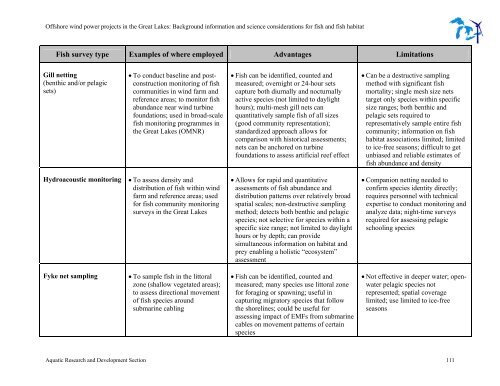Offshore Wind Power Projects in the Great Lakes - Ministry of ...
Offshore Wind Power Projects in the Great Lakes - Ministry of ...
Offshore Wind Power Projects in the Great Lakes - Ministry of ...
You also want an ePaper? Increase the reach of your titles
YUMPU automatically turns print PDFs into web optimized ePapers that Google loves.
<strong>Offshore</strong> w<strong>in</strong>d power projects <strong>in</strong> <strong>the</strong> <strong>Great</strong> <strong>Lakes</strong>: Background <strong>in</strong>formation and science considerations for fish and fish habitat<br />
Fish survey type Examples <strong>of</strong> where employed Advantages Limitations<br />
Gill nett<strong>in</strong>g<br />
(benthic and/or pelagic<br />
sets)<br />
Hydroacoustic monitor<strong>in</strong>g<br />
Fyke net sampl<strong>in</strong>g<br />
• To conduct basel<strong>in</strong>e and postconstruction<br />
monitor<strong>in</strong>g <strong>of</strong> fish<br />
communities <strong>in</strong> w<strong>in</strong>d farm and<br />
reference areas; to monitor fish<br />
abundance near w<strong>in</strong>d turb<strong>in</strong>e<br />
foundations; used <strong>in</strong> broad-scale<br />
fish monitor<strong>in</strong>g programmes <strong>in</strong><br />
<strong>the</strong> <strong>Great</strong> <strong>Lakes</strong> (OMNR)<br />
• To assess density and<br />
distribution <strong>of</strong> fish with<strong>in</strong> w<strong>in</strong>d<br />
farm and reference areas; used<br />
for fish community monitor<strong>in</strong>g<br />
surveys <strong>in</strong> <strong>the</strong> <strong>Great</strong> <strong>Lakes</strong><br />
• To sample fish <strong>in</strong> <strong>the</strong> littoral<br />
zone (shallow vegetated areas);<br />
to assess directional movement<br />
<strong>of</strong> fish species around<br />
submar<strong>in</strong>e cabl<strong>in</strong>g<br />
• Fish can be identified, counted and<br />
measured; overnight or 24-hour sets<br />
capture both diurnally and nocturnally<br />
active species (not limited to daylight<br />
hours); multi-mesh gill nets can<br />
quantitatively sample fish <strong>of</strong> all sizes<br />
(good community representation);<br />
standardized approach allows for<br />
comparison with historical assessments;<br />
nets can be anchored on turb<strong>in</strong>e<br />
foundations to assess artificial reef effect<br />
• Allows for rapid and quantitative<br />
assessments <strong>of</strong> fish abundance and<br />
distribution patterns over relatively broad<br />
spatial scales; non-destructive sampl<strong>in</strong>g<br />
method; detects both benthic and pelagic<br />
species; not selective for species with<strong>in</strong> a<br />
specific size range; not limited to daylight<br />
hours or by depth; can provide<br />
simultaneous <strong>in</strong>formation on habitat and<br />
prey enabl<strong>in</strong>g a holistic “ecosystem”<br />
assessment<br />
• Fish can be identified, counted and<br />
measured; many species use littoral zone<br />
for forag<strong>in</strong>g or spawn<strong>in</strong>g; useful <strong>in</strong><br />
captur<strong>in</strong>g migratory species that follow<br />
<strong>the</strong> shorel<strong>in</strong>es; could be useful for<br />
assess<strong>in</strong>g impact <strong>of</strong> EMFs from submar<strong>in</strong>e<br />
cables on movement patterns <strong>of</strong> certa<strong>in</strong><br />
species<br />
• Can be a destructive sampl<strong>in</strong>g<br />
method with significant fish<br />
mortality; s<strong>in</strong>gle mesh size nets<br />
target only species with<strong>in</strong> specific<br />
size ranges; both benthic and<br />
pelagic sets required to<br />
representatively sample entire fish<br />
community; <strong>in</strong>formation on fish<br />
habitat associations limited; limited<br />
to ice-free seasons; difficult to get<br />
unbiased and reliable estimates <strong>of</strong><br />
fish abundance and density<br />
• Companion nett<strong>in</strong>g needed to<br />
confirm species identity directly;<br />
requires personnel with technical<br />
expertise to conduct monitor<strong>in</strong>g and<br />
analyze data; night-time surveys<br />
required for assess<strong>in</strong>g pelagic<br />
school<strong>in</strong>g species<br />
• Not effective <strong>in</strong> deeper water; openwater<br />
pelagic species not<br />
represented; spatial coverage<br />
limited; use limited to ice-free<br />
seasons<br />
Aquatic Research and Development Section 111
















